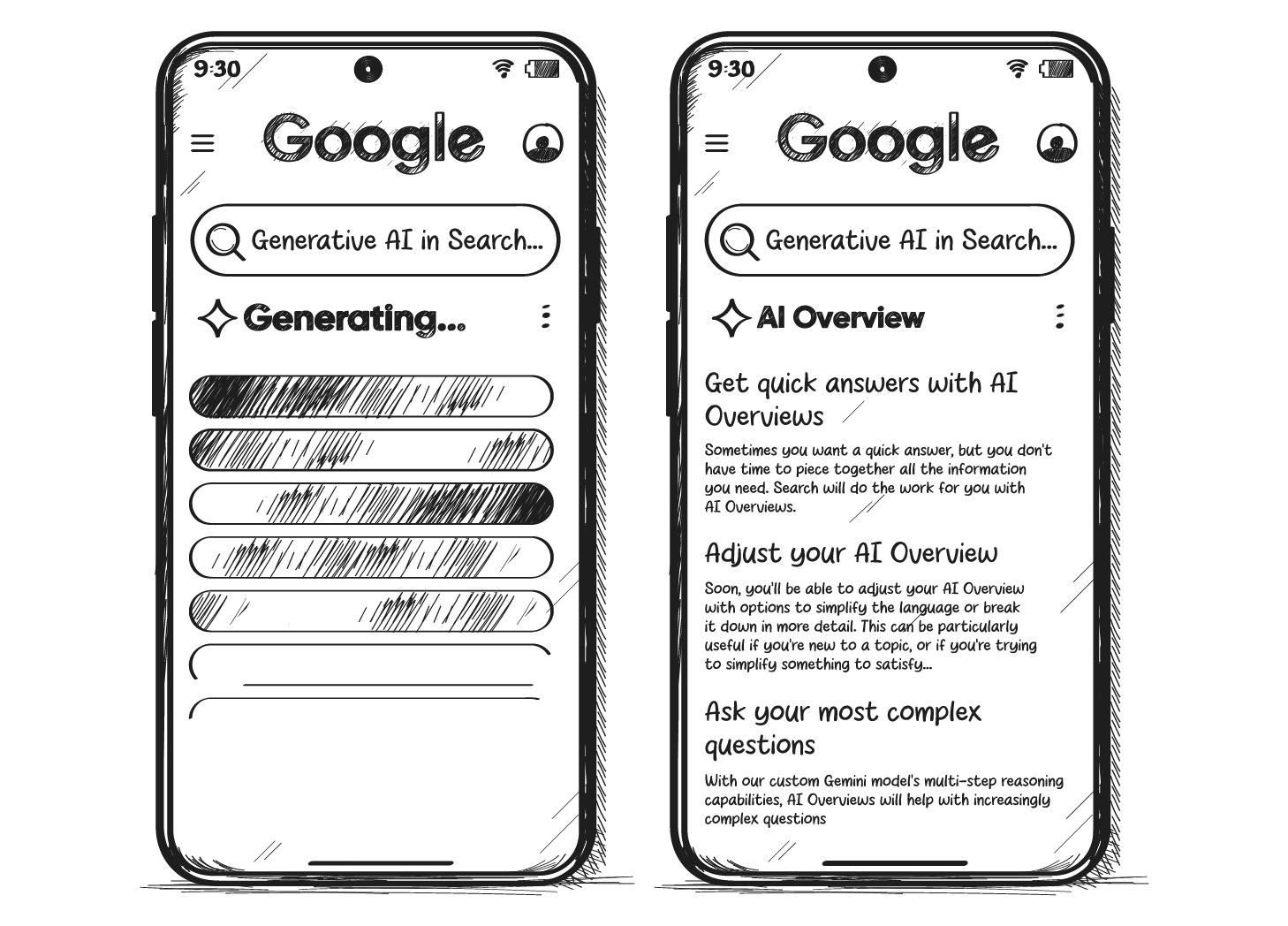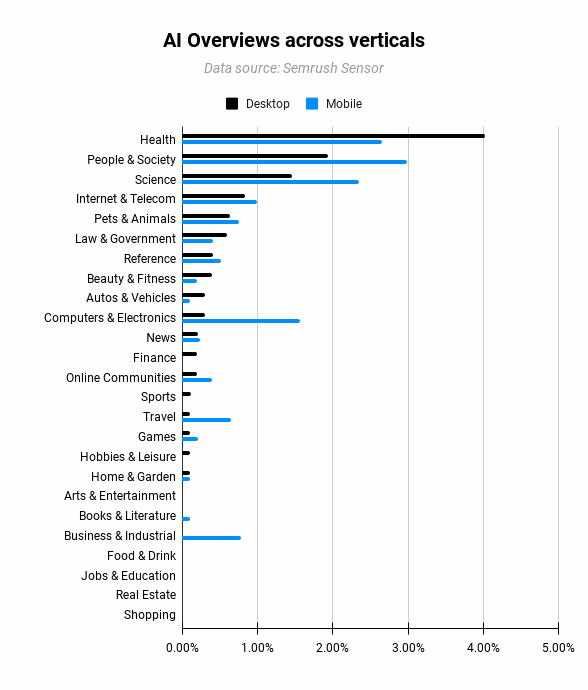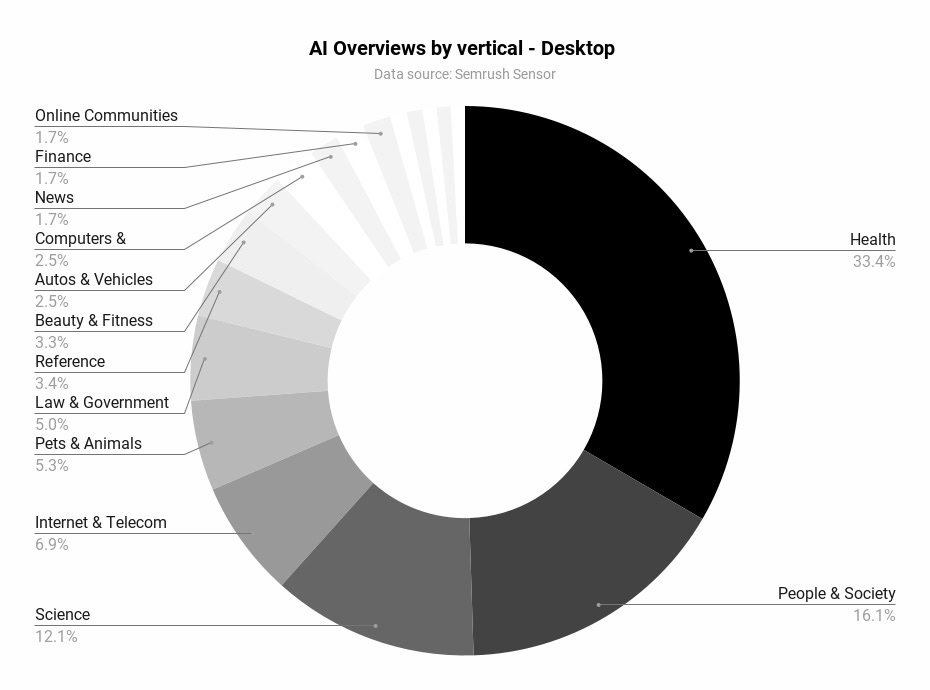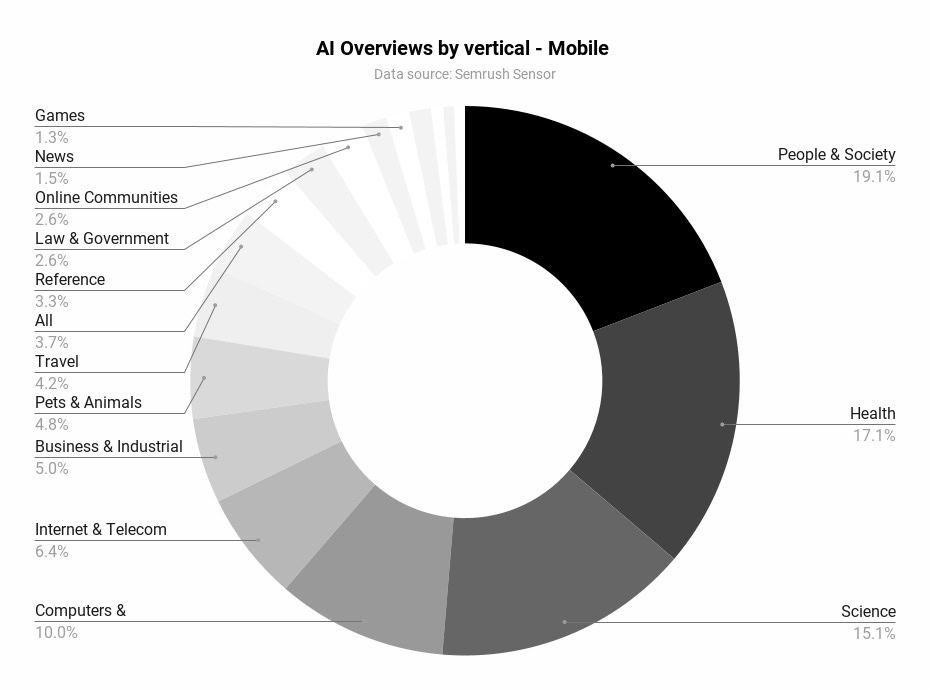Google I/O 2024 was all about one thing: the launch of AI Overviews (short: AIOs). You might know the Gemini-powered direct answers as AI Snapshots from Google’s public beta environment Search Generative Experience. Now, they’re here, ushering in a new era for Search.
Google’s stunning first quarter and the softening of the ChatGPT hype led me to believe that Google had no reason to launch AIOs. Clearly, I was wrong.
So, why did it launch AIOs? A few possible reasons:
- Optics.
- Google wants to disrupt itself before someone else does.
- AIOs massively improve the experience for long-tail queries.
- Higher pressure from Perplexity, ChatGPT & Co. than we thought.
- Google might as well give the answer itself, given the low quality of open web content.
- AI results allow searchers to do the actual thing instead of reading about how to do it.
Are AIOs the end of Google Search as we know it? Yes. Is that good? Also, yes. Every tech advancement bears threats, but also opportunities.
 Image Credit: Lyna ™
Image Credit: Lyna ™Boost your skills with Growth Memo’s weekly expert insights. Subscribe for free!
From Queries To Prompts
We’re entering a new era of Search because AIOs are a new playing field with new rules. They look like 18-year-old Featured Snippets on ‘roids, but they’re not. Classic ranking factors don’t apply.
Instead, Google blurs the line between searching and doing.
Liz Reid, Google’s head of Search, calls the capabilities of AIOs “agentive,” referring to their role as agents who can do things for you. Giving answers to questions is just one task of many.
In their full glory, agentive AIOs expand to what Google calls “AI-organized search results.” Instead of blue links, Gemini composes a personalized feed of local results, short videos, and forums based on your prompt.
Google plays into its competitive advantage of owning Maps, Gmail, YouTube, Chrome, and Android. AI-organized SERPs are rolling out for inspirational queries, but I don’t see why they wouldn’t appear for commercial queries as well.
Instead of giving you answers, AIOs are the gateway to AI in Google Search that does things for you. The future of Search isn’t keywords but prompts.
AIOs show up for complex queries where Google attempts “… to make an algorithmic value judgment behind the scenes as to whether it should serve up AI-generated answers or a conventional blue link to click.”
“Complex queries” sounds much like long-tail queries, where Google’s search experience has traditionally been horrendous despite “using AI for years.”
AIOs and classic search results are powered by different systems. Proof: Sites that were punished by Google penalties can still appear with content and sources in AIOs.
AIOs use multi-step reasoning, which breaks searches (prompts) down into parts, answers each one, and puts the answer back together. This approach sounds a lot like chain-of-thought prompting, where a large language model (LLM) explains each step when giving an answer.
In Search, users might be able to give feedback on single parts of an answer and fine-tune Gemini’s understanding of user intent and personalization capabilities.
New technology introduces costs and benefits. I admit, AIOs improved a lot in SGE just before they launched. I also think AIOs are a better experience for users and a long desired update to how Google works. It’s our job to figure out how they work and how to gain visibility.
Here is the good, the bad, and the ugly of AIOs.
The Good
1. Early data shows that AIOs appear for only 0.48% of desktop and 0.57% of mobile search results.
 Early data shows very few AIOs in Search. (Image Credit: Kevin Indig)
Early data shows very few AIOs in Search. (Image Credit: Kevin Indig)Rank trackers measure SERP features based on the logged-out experience, which might be different from personalized user results.
For now, it seems you have a higher chance of getting audited by the IRS than seeing an AIO.
Early data shows that Google doesn’t shy away from giving AI answers in sensitive spaces like health, science, pets, and law. It’s questionable whether that’s a good way to start.
Verticals like people, beauty, and sports would forgive mistakes so much more.
 The majority of AI Overviews on desktop show up in health, people & society, and science verticals. (Image Credit: Kevin Indig)
The majority of AI Overviews on desktop show up in health, people & society, and science verticals. (Image Credit: Kevin Indig) The majority of AI Overviews on mobile show up in people & society, health, and science verticals. (Image Credit: Kevin Indig)
The majority of AI Overviews on mobile show up in people & society, health, and science verticals. (Image Credit: Kevin Indig)2. What I’m most excited about: AIOs could be a massive opportunity to match searchers with the right site – better and faster.
According to Sundar Pichai, SGE led to longer queries. Assuming engagement with AIOs follow suit, longer queries reveal more about what users really want (intent), similar to how social networks measure behavior.
As a result, AIOs likely shrink organic traffic, but bring more organic conversions – more juice, less squeeze.
3. Lower cost-per-click (CPC).
CPCs are high and getting more expensive. But if AIOs and AI-organized SERPs can connect users with the right company faster, CPCs go down because fewer advertisers compete with each other for the same searcher.
Google could significantly grow monetizable queries in the long-tail queries. Win-win.
The Bad
1. Misinformation.
Examples of AIOs contaminated with misinformation or questionable answers are easy to find. It’s clear that Google tolerates some degree of misinformation or poor results.
Of course, Google needs to fix misinformation as fast as possible, especially in sensitive areas like health or law. But AIOs also magnify an uncomfortable fact: The web has been full of misinformation for a while.
Consensus is easier for some topics than others. I do have hope that AI, in general, makes it easier to identify misinformation.
We’re also facing a denominator trap in the debate about how much wrong information is okay: We don’t know how many AIOs deliver correct vs. factually wrong results. It might just be a tiny fraction, but misinformation sticks out like a sore thumb.
The same is true for good vs. bad experiences with AIOs. There is a chance the absolute majority of experiences are good.
2. Traffic loss.
Travel sites, publishers, and affiliates will suffer from the launch of AIOs, especially AI-organized SERPs cut deep into the flesh or sites that help with creative tasks, information gathering, and product reviews.
The winners are brands, vendors, and creators who don’t make money from advertising but sell “products.”
3. AIOs break the old contract between Google, searchers, and content creators.
People and companies created content that Google could run ads against and received traffic in return.
Now that anybody can recreate Wikipedia’s content with basic LLMs, Google might as well give the answer itself and send traffic only when users want to explore more.
 The old contract between Google, content creators, and searchers is void. (Image Credit: Kevin Indig)
The old contract between Google, content creators, and searchers is void. (Image Credit: Kevin Indig)AIOs still have links, and we’ll soon figure out how much traffic they actually send out. But links in AIOs have another important mission: Create trust with users by showing where the information comes from.
The Ugly
People have already used AI Overviews billions of times through our experiment in Search Labs. They like that they can get both a quick overview of a topic and links to learn more. We’ve found that with AI Overviews, people use Search more, and are more satisfied with their results.
1. Baseless claims.
Google claims that AI Overviews lead to more searches and better satisfaction. Isn’t that a paradox? Shouldn’t a better experience result in fewer searches?
Pichai also mentioned an “increase in engagement.” Again, what does that mean?
With AI Overviews, people are visiting a greater diversity of websites for help with more complex questions. And we see that the links included in AI Overviews get more clicks than if the page had appeared as a traditional web listing for that query.
The announcement sounds like “top results get more traffic,” but what it actually means is that Google shows different sites in AIOs than in classic web search, which get more traffic since they don’t rank well in classic search but now get featured in AIOs.
2. Data loss.
The worst part about AI Overviews is that Google doesn’t provide telemetry to understand their impact. Clicks and impressions for AIOs will not be separable from classic results. I couldn’t imagine an easier way for Pichai & Co. to prove that AIOs are better for the web than letting sites measure referral traffic.
“Google CEO Sundar Pichai suggested that offering granular AI preview traffic data might encourage website owners to manipulate the system.
He believes providing detailed metrics could result in publishers designing their content specifically to game Google’s search engine, which may lead to a worse user experience.”
The future of organic visibility tracking is a combination of first-party data (Google Search Console) enhanced with third-party tools that fill the gaps.
AIOs might surface more personalized results, but we can leverage technology to solve this problem.
AI bots could be trained on human search behavior and emulate personas to search and scrape Google’s logged-in experience to give us an approximation of personalized human search results. Google is not the only one that benefits from advancements in AI.
3. No opt-out.
In classic Google fashion, you can’t really opt out of AIOs. It’s not a great look, given the bad image AI answers already have.
You can use a nosnippet meta tag but cripple yourself in the process because you also lose your description and rich snippets.
Searchers can’t opt out of AIOs either and have to install Chrome extensions to get rid of them.
Moving Forward
We will deal with this change like any other change before: SSL encryption, mobile, SERP features, Helpful Content Update (HCU), etc. Like every other time, we’ll measure, test, learn, and adapt.
Besides ranking algorithms, we now also need to stay on top of Google’s AI models because they define what’s possible for AIOs and AI-organized SERPs.
For example, Gemini 1.5 Pro will have a 2 million-token context window by the end of the year. That’s the equivalent of 2 hours of videos, 22 hours of audio, and 1.4 million words.
Capabilities matter because they impact user behavior. For example, AIOs lead to a lot more long-tail queries (as confirmed by Sundar Pichai) and voice searches.
We need to start paying attention to training tokens, multi-modal capabilities, zero-shot tasks, speed, etc., and talk about new models like new ranking algorithms.
It’s the End of Google Search As We Know It
Google Won’t Commit To AI Search Traffic Data In Search Console
Google’s generative AI can now analyze hours of video
Featured Image: Paulo Bobita/Search Engine Journal
